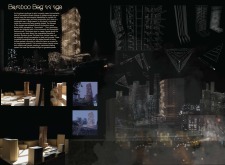5 key facts about this project
The design centers on an innovative use of bamboo as the primary structural element, addressing climate change while enhancing community connection. Located in a setting that values sustainability, the structure functions as a space where people can learn about the advantages of bamboo. The overall concept revolves around a bamboo space frame that symbolizes growth and abundance, linking the natural environment with modern architectural practices.
Conceptual Framework
The project is based on a bamboo space frame, which provides structural support while also fostering a conversation about sustainable materials. This framework embodies principles of growth and diversity, serving both practical and educational roles in the community. The design encourages interaction and engagement, creating an environment that promotes exploration and appreciation of nature.
Material Properties
Bamboo is selected for its impressive qualities, including rapid growth and strength comparable to traditional materials like steel and concrete. Its hollow structure allows for unique design possibilities, facilitating the integration of mechanical systems within the building. This choice reflects a commitment to innovation in materials and a re-examination of typical construction methods.
Mechanical Integration
The bamboo framework also hosts a mechanical shading system that includes motors, tension wires, and rollable solar panels. This system enables adjustments to environmental conditions, optimizing sunlight exposure and improving energy efficiency. By generating power from sunlight, the design addresses functional needs and demonstrates modern strategies for sustainability.
Design Aesthetics
The final design detail highlights the blend of functionality and visual appeal. The bamboo frame, along with the mechanical shading elements, creates an engaging and vibrant environment. This thoughtful design invites users to appreciate the natural qualities of bamboo while interacting with a space that supports sustainability, reinforcing the bond between the built environment and its ecological settings.



















































